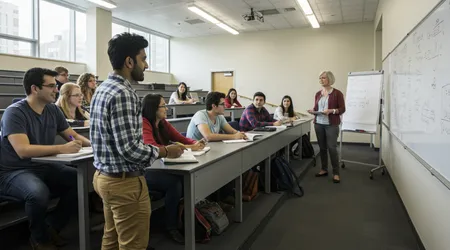Studying in Canada: A Step-by-Step Guide for International Students

Studying in Canada draws thousands of global students yearly, captivated by its world-class education and vibrant culture.
In 2025, Canada remains a top destination, blending academic excellence with welcoming communities.
This guide walks you through every step, from choosing a program to settling in, with practical insights for success.
Whether you’re dreaming of urban campuses or coastal colleges, let’s explore how to make your Canadian education a reality.
Canada’s appeal lies in its diversity both in its people and its institutions. You’ll find programs tailored to every ambition, from tech innovation to liberal arts.
The journey, though, starts with clarity. Why Canada? Beyond academics, it offers pathways to work and residency.
This guide breaks it down, ensuring you’re ready for the adventure.
Step 1: Research Programs and Institutions
Choosing where to study begins with understanding your goals. Studying in Canada means picking from universities, colleges, or technical institutes.
Universities like UBC or McGill excel in research, while colleges like Seneca focus on hands-on skills. Align your choice with career aspirations.
Start by exploring program websites. Check admission requirements, course details, and faculty profiles.
For example, if engineering calls you, compare UBC’s project-based learning with U of T’s global internships. Canada hosted 1,012,000 international students in 2023, per IRCC, showing its global pull.
++ The Best Universities in Canada for 2025: A Complete Ranking
Don’t overlook scholarships. Many schools offer merit-based awards for international students.
Create a spreadsheet to track deadlines and criteria. This keeps your options organized and stress low.
Location matters too. Urban Toronto buzzes with opportunity, while smaller cities like Halifax offer tight-knit communities.
Research living costs Vancouver’s pricier than Winnipeg. Balance academics with lifestyle to find your fit.

Step 2: Understand Admission Requirements
Every program has unique entry rules. Studying in Canada requires meeting academic and language standards. Most universities ask for a high school diploma or equivalent.
Colleges may accept vocational backgrounds for applied programs.
English or French proficiency is key. IELTS and TOEFL are widely accepted for English. Aim for IELTS 6.5 or higher for universities.
Also read: Education for Adults in Canada: Options in 2025
French programs, common in Quebec, often require TEF. Check specific score thresholds early.
Some fields, like medicine, demand prerequisite courses. Others, like business, may request portfolios or essays.
For instance, McMaster’s health sciences program requires a detailed supplementary application. Review these on school websites.
Deadlines vary January for fall intakes is common. Apply early to secure spots and scholarships.
Use tools like OUAC for Ontario universities to streamline applications. Stay proactive to avoid last-minute hurdles.
Step 3: Navigate the Study Permit Process
A study permit is your ticket to studying in Canada.
Apply after receiving an acceptance letter from a Designated Learning Institution (DLI). IRCC’s website details the process, updated for 2025.
You’ll need proof of funds around CAD 20,635 per year outside Quebec, plus tuition. A bank statement or sponsorship letter works.
Include your acceptance letter and a statement of purpose explaining your study plans.
Read more: How to Apply for Student Loans in Canada
Biometrics and medical exams may be required, depending on your country. Processing times vary; India takes about 7 weeks, per 2025 IRCC data.
Apply online for faster results, and double-check documents to avoid delays.
Once approved, your permit arrives with conditions, like study hours. Keep it valid extensions are possible if your program runs long.
Save digital copies for easy access during travel or inspections.
Step 4: Plan Your Finances
Money matters when studying in Canada. Tuition ranges from CAD 20,000 to 60,000 annually, depending on the program.
Medicine and engineering lean toward the higher end, per 2025 CBIE data. Budget for living costs too around CAD 15,000 yearly in cities like Toronto.
| Expense Type | Estimated Cost (CAD) |
|---|---|
| Tuition (Undergrad) | 20,000–60,000/year |
| Accommodation | 8,000–15,000/year |
| Food | 3,000–5,000/year |
| Transportation | 1,200–2,000/year |
| Health Insurance | 600–1,000/year |
Scholarships ease the load. Vanier Canada Graduate Scholarships offer CAD 50,000 for doctoral students. Check school websites for entrance awards.
Part-time work up to 20 hours weekly helps too.
Create a monthly budget. Apps like Mint track spending. Share accommodations to cut rent costs.
Planning ahead avoids financial stress, letting you focus on studies.
Explore bursaries for unexpected needs. Many schools, like UBC, offer emergency funds for international students.
Apply early, as funds are limited, and keep receipts for transparency.
Step 5: Arrange Accommodation and Travel
Finding a home is crucial for studying in Canada. On-campus dorms, like those at UBC, cost CAD 8,000–12,000 yearly and offer community vibes.
Off-campus rentals, pricier in cities like Vancouver, give independence.
Book housing early dorms fill fast. Websites like Places4Students list verified rentals. For example, a shared Toronto apartment might run CAD 1,200 monthly. Inspect places virtually if possible.
Travel planning follows. Book flights early for deals Skyscanner shows trends. Arrive a week before classes to settle in.
Canada’s winters demand warm clothing; budget CAD 500 for a good coat and boots.
Health insurance is mandatory. Provinces like Ontario provide OHIP for students after 153 days; private plans cover the gap. Research your province’s rules to stay protected.
Join student forums like Reddit’s r/UofT for housing tips.
Locals often share leads on affordable spots. Networking early builds connections and confidence before arrival.
Step 6: Prepare for Life in Canada
Adapting to studying in Canada means embracing new rhythms. Canada’s multicultural cities, like Vancouver, blend global cuisines and festivals.
Yet, winters can hit -30°C in places like Winnipeg pack layers.
Orientation programs help. Universities like McGill host week-long welcomes, pairing you with mentors.
Join clubs hiking at UBC or debate at U of T to find friends. Connection fights homesickness.
Part-time work builds skills. Cafes or libraries hire students, paying CAD 15–20 hourly. Balance shifts with studies to maintain grades, as permits limit work hours.
Mental health matters. Schools offer free counseling UBC’s Wellness Centre is a model. Reach out early if stress creeps in; support is stigma-free.
Explore beyond campus. Niagara Falls or Banff’s mountains are accessible by bus or student discounts.
These trips recharge you, blending adventure with academic focus.
Step 7: Leverage Post-Graduation Opportunities
Studying in Canada opens doors beyond the classroom.
The Post-Graduation Work Permit (PGWP) lets you work up to three years after graduating. It’s a game-changer for career starters.
Apply within 180 days of finishing your program. No job offer is needed, giving flexibility. IRCC reports 70% of PGWP holders transition to permanent residency, a global draw.
Networking is key. Attend job fairs U of T’s career expos connect students with firms like Deloitte. Update LinkedIn with Canadian projects to attract recruiters.
Consider further studies. A master’s boosts credentials, and provinces like Ontario offer nomination programs for graduates. Research pathways early to align with goals.
Gain local experience. Internships, like those at UBC’s co-op programs, build resumes.
Volunteer at festivals or NGOs to show community ties, strengthening residency applications.
Step 8: Build a Support Network
No one thrives alone while studying in Canada. Universities offer international student offices, like York’s, with visa advice and cultural workshops. Tap into these early.
Connect with peers. Group chats on WhatsApp or Discord spark friendships. For example, UBC’s Indian Student Association hosts Diwali events, easing cultural transitions.
Mentors guide you. Professors or advisors, like those at McGill, offer office hours. Ask about research or internships to deepen ties and open doors.
Community groups ground you. Toronto’s cultural centers, like the Chinese Cultural Centre, host language exchanges. These spaces feel like home amid newness.
Online platforms help too. Join CanadaVisa forums for permit tips.
Real stories from students worldwide offer practical hacks, building confidence for your journey.

Conclusion
Studying in Canada transforms dreams into reality with planning and grit. From picking a program to securing a permit, each step builds your future.
Canada’s campuses, rich with diversity, prepare you for global success. Embrace challenges language tests, budgets, or snowy winters as growth moments. The reward?
A degree, work experience, maybe residency. Start today: research one school, note one deadline. Your Canadian story awaits, bold and yours to write.
This journey isn’t just academic. It’s about finding your place in a country that values ideas and ambition.
Connect with others, explore new horizons, and let Canada shape your path.
Frequently Asked Questions
1. How long does it take to get a study permit?
Processing varies by country about 7 weeks for India in 2025, per IRCC. Apply early online.
2. Can I work while studying in Canada?
Yes, up to 20 hours weekly part-time during semesters, full-time during breaks, with a valid permit.
3. Are scholarships available for international students?
Many exist, like Vanier or school-specific awards. Check university websites for eligibility and deadlines.
4. What’s the cost of living in Canada?
Roughly CAD 15,000 yearly, varying by city Toronto’s higher, Winnipeg’s lower. Budget for rent, food, transit.
5. Can I stay in Canada after graduating?
Yes, a PGWP allows work for up to three years, often leading to permanent residency pathways.
